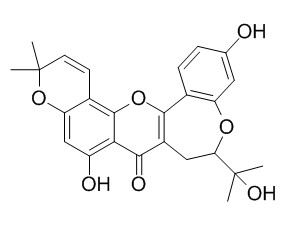Neocyclomorusin
Neocyclomorusin displays minimal inhibitory concentration (MIC) value of 4 ug/mL against Klebsiella pneumoniae ATCC11296, Enterobacter cloacae BM47.
Inquire / Order:
manager@chemfaces.com
Technical Inquiries:
service@chemfaces.com
Tel:
+86-27-84237783
Fax:
+86-27-84254680
Address:
1 Building, No. 83, CheCheng Rd., Wuhan Economic and Technological Development Zone, Wuhan, Hubei 430056, PRC
Providing storage is as stated on the product vial and the vial is kept tightly sealed, the product can be stored for up to
24 months(2-8C).
Wherever possible, you should prepare and use solutions on the same day. However, if you need to make up stock solutions in advance, we recommend that you store the solution as aliquots in tightly sealed vials at -20C. Generally, these will be useable for up to two weeks. Before use, and prior to opening the vial we recommend that you allow your product to equilibrate to room temperature for at least 1 hour.
Need more advice on solubility, usage and handling? Please email to: service@chemfaces.com
The packaging of the product may have turned upside down during transportation, resulting in the natural compounds adhering to the neck or cap of the vial. take the vial out of its packaging and gently shake to let the compounds fall to the bottom of the vial. for liquid products, centrifuge at 200-500 RPM to gather the liquid at the bottom of the vial. try to avoid loss or contamination during handling.
Front Microbiol.2023, 14:1232039.
Arch Toxicol.2024, 98(5):1415-1436.
Chem Biol Interact.2023, 378:110487.
Fitoterapia.2022, 157:105130.
Pharmacognosy Journal2019, 11(2): 369-373
Front Pharmacol.2019, 10:1355
Genes Environ.2024, 46(1):13.
Nutrients.2019, 11(6):E1380
University of Burgos2024, ssrn.4795441.
J Mass Spectrom.2022, 57(2):e4810.
Related and Featured Products
Yao Xue Xue Bao. 2015 May;50(5):579-82.
Chemical constituents from Morus notabilis and their cytotoxic effect.[Pubmed:
26234140]
METHODS AND RESULTS:
Une new flavonoids named as notabilisin K (1), together with tour known compounds, morusin (2), mulberrofuran A (3), Neocyclomorusin (4) and mornigrol F (5) are separated from 95% ethanol extracts of the twigs of Morus notabilis. Compounds 2-5 are separated from this plant for the first time. Notabilisin I, notabilisin J exhibits certain effect against cells of HCT-116, HepG2 and A2780 with IC50 values ranging from 1.47 μmol x L(-1) to 5.46 μmol x L(-1).
CONCLUSIONS:
Morusin exhibits strong effect against five kinds of human cancer cells (BGC823, A2780, HCT-116, HepG2 and NCI-H1650) with IC50 values ranging from 0.74 μmol x L(-1) to 1.58 μmol x L(-1).
Springerplus. 2015 Dec 30;4:823.
Antibacterial activity of nineteen selected natural products against multi-drug resistant Gram-negative phenotypes.[Pubmed:
26753111 ]
The present study was designed to assess the antimicrobial activity of 19 natural products belonging to terpenoids, alkaloids, thiophenes and phenolics against a panel of 14 Gram-negative multidrug-resistant (MDR) bacteria.
METHODS AND RESULTS:
The results demonstrated that amongst the studied compounds, alkaloids and terpenoids were less active contrary to flavonoids: Neocyclomorusin (3) and candidone (6) and isoflavonoids: neobavaisoflavone (8) and daidzein (12). Thiophene, 2-(penta-1,3-diynyl)-5-(3,4-dihydroxybut-1-ynyl)thiophene (17) showed moderate and selective activities. Compounds 3, 6, 8 and 12 displayed minimal inhibitory concentration (MIC) ranged from 4 to 256 μg/mL on all the 14 tested bacteria. MIC values below 10 μg/mL were obtained with 8, 3, 6 and 12 against 50, 42.9, 35.7 and 21.4 % of the tested bacteria. The lowest MIC value of 4 μg/mL was obtained with compound 3 against Klebsiella pneumoniae ATCC11296, Enterobacter cloacae BM47, compound 6 against Escherichia coli ATCC8739, K. pneumoniae ATCC11296, E. cloacae BM47 and compound 8 against K. pneumoniae ATCC11296 and E. cloacae BM47. The activity of flavonoid 3 was better or equal to that of chloramphenicol in all tested K. pneumoniae, Providencia stuartii, E. aerogenes, E. cloacae and Pseudomonas aeruginosa strains. Within isoflavonoids, neobavaisoflavone scaffold was detected as a pharmacophoric moiety.
CONCLUSIONS:
This study indicates that natural products such as 3, 6 and 8 could be explored more to develop antimicrobial drugs to fight MDR bacterial infections.



